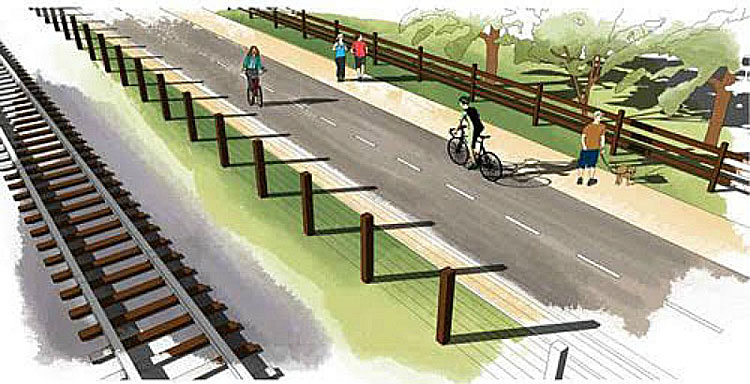By George Dondero

The role of the Regional Transportation Commission (RTC) is to provide options for the broad range of people in our community: commuters, our aging population, those who depend on transit, people with disabilities, businesses, bicyclists, walkers and residents living in each town in our diverse county.
The rail transit feasibility study of 2015 was not a proposal for rail transit. The hypothetical estimates in the study are not under consideration by the RTC as options for the future. The 2015 study is not viewed as a blueprint for the future—the RTC does not envision a future with low-tech trains moving at dangerous speeds through our neighborhoods.
However, the rail feasibility study was a theoretical look, based on the types of service for which data was available at the time, at what was possible on the rail line.
Also theoretical is the concept called “rail banking.” It certainly sounds tantalizing: pull up the tracks now and then put them back in some day in the future, if the community so decides. The reality is that after thousands of miles of tracks have been torn up during the more than three decades since the term was coined through an act of Congress, not a single mile of track is believed to ever have been replaced. While it is an attractive idea, the truth is that no one has ever seen rail return after it as been designated “rail banked.”
The Unified Corridors Study is taking a look at three possible options for use of the rail corridor: rail line with a trail, a trail only (no rail), and bus rapid transit. There are a couple of myths to be debunked here. In the case of the “rail with trail” scenario, the study does not envision the RTC would propose to run trains on the track immediately. It does, however, envision the tracks would be preserved for future use, if the community decided to pursue funding.
Another myth is that there is an option that would enable a trail to be built very quickly. In all scenarios, construction of a trail will take time, due to planning and environmental review, approval by the Coastal Commission, etc. The one exception to this is the segment that runs through the West Side of the City of Santa Cruz and the one in Watsonville from Lee Road to Walker St. Those segments, as approved by the Santa Cruz and Watsonville City Councils, are scheduled to be under construction in 2018 and 2019, respectively, as rail with trails.
A related issue is the idea that the RTC could simply use Measure D funds to pay back the State the $11 million that it provided to purchase the rail corridor on behalf of the public. The funds from the State came with the requirement that they be returned if the community decides to pull up the tracks. The current approved spending plan for Measure D does not have funds set aside for this purpose, nor was this use of funds presented to the voters.
However, Measure D funds have been approved to survey the rail corridor to determine the actual boundaries of the corridor. Surveys are often revealing, showing rail-trail width information that may be different from what is assumed in the advocacy for one option or another. Conducting needed survey work is a critical early step in developing any trail project (with or without a rail line or other transit).
Before drawing any conclusions on the best use of the rail line, the Unified Corridor Investment Study needs to be completed. It will inform RTC Commissioners and the public about a recommended use for the rail corridor based upon clear performance metrics.
What is the best use? Whatever the answer is, it will take a broad view and will prioritize future investments in the rail corridor, as well as the Highway 1 and Soquel Drive/Freedom Boulevard corridors.
Every scenario, in all three corridors, will be evaluated for environmental and climate impacts, how it supports our local economy and how it addresses equity in terms of how well it serves the entire population of the county, from South County to Mid County to North County. It is through these lenses—environment, economy and equity—that the various ideas for our future transportation vision will be studied, and ultimately judged.
From multi-use trails and battery-powered trains to e-bikes and bus rapid transit, the RTC is receiving many ideas and much feedback as the Unified Corridors Study moves forward. Please visit www.sccrtc.org<http://www.sccrtc.org> to learn more, get the facts and sign up for our email newsletter.
No matter the outcome of the ongoing community dialog and study, the RTC is committed to empirical analysis, transparency in the process and honoring the will of the voters who passed Measure D one year ago. On the issue of transportation, our community is engaged and this is a very good thing.
•••
George Dondero serves as the executive director of the Santa Cruz County Regional Transportation Commission.
For another point of view on this subject, CLICK HERE